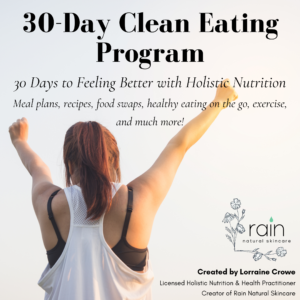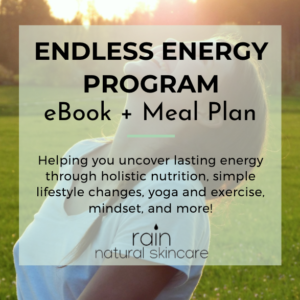Instead of obsessing over numbers on nutrition labels, read the actual ingredients. Instead of obsessing over how much to eat, just eat real food. We have become so obsessed with food labels that we have turned our food into the enemy by thinking of it only as calories in and calories out. We need to fall in love with food again by choosing food in its original form.
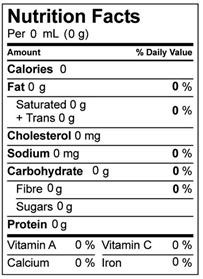
I remember as a parent trying to find healthy and nutritious snacks for my kids, especially to send to school. Simple and easy snacks are always great for busy parents, but not always the best when it comes to the quality of the snacks. We all want to know what we are eating, so taking the time to learn how to read nutrition facts labels is great, but is it? Keep reading to see what I mean….
There are so many nutrition ‘rules’ out there that we all find confusing, such as: what to eat when to eat, what makes a healthy diet, or how to figure out the best dietary approach for our needs. But one of the most confusing is how to read nutrition labels. Therefore I want to talk about ways to help you learn how to read nutrition labels.
A nutrition label contains the details of the nutrients, nutrient values, daily intakes, calories, grams of carbs, fats and proteins, etc. Most of the time, if it has a label, I skip it. It’s easier that way! Let me explain what I mean by showing some of the major points of a nutrition label.
CALORIES
This is the part of a label that people often read first. But here’s the problem: this value will tell you how many calories are in a food, but it doesn’t tell you much about the ingredients that contribute to those calories. It’s not necessarily about how many calories are in a serving, but where those calories are coming from. Are they nutrient-dense calories or are they full of lots of nutritious value?
For example, a dish of cut-up carrots has about 50 calories, and so do 3 Ritz crackers. Does this make them equal in nutritional value? Definitely not! Another example is half of a Chocolate Pop Tart has 180 calories and a serving of oatmeal has 150. Looking further, you’ll notice that the calories in a bowl of oatmeal come from a healthy ratio of fats, proteins and carbs (mainly fibre) and 143 of the 180 calories in a Pop Tart come from starch and sugar.
At the end of the day, calories don’t always matter! Read my post here about clean eating vs calorie counting.
FAT
Recent nutritional research has shown that most of the belief we grew up on, that fat was ‘bad’ is completely false. Fat is an incredibly dense nutrient that fuels every single cell of our bodies, nourishes our nervous system, helps us make hormones, supports the brain, balances blood sugar and lubricates our joints.
However, when we look at that high number of fat grams on a label we still tend to freak out. Designating a certain number as ‘too much’ fat is unhelpful, especially when we don’t know where those fats are coming from. As with calories, there are good sources of fat and toxic sources of fat. Coconut oil, coconut milk, organic butter, avocado, nuts and seeds are all amazing examples of healthy nourishing fats, while rancid, highly processed and genetically modified oils such as canola, vegetable, safflower, corn and cottonseed are bad for our health.
Just looking at the total number of fat grams, doesn’t give us the whole picture. And if we make decisions based on that number, we might be missing out on an excellent source of nutritious fats that our body needs.
VITAMINS AND MINERALS
Most labels will include some mention of vitamins and minerals such as sodium, potassium, calcium, iron, Vitamin C, Vitamin A and more.
What a label won’t tell you is the quality of those vitamins and minerals. Many processed foods are fortified (or added in) with vitamins and minerals which are different than the forms you’d find in whole foods and aren’t as easy for us to digest, absorb and use. This means you may not be actually receiving the benefit from the vitamins and minerals listed on the labels. Another thing to keep in mind is the ‘daily recommended intakes’ on labels are often far lower than what we truly need, especially if we are dealing with a specific health condition.
In the example below, see all the ingredients listed on a box of Ritz crackers. What about a carrot, what’s on its ingredient list, um…carrot!
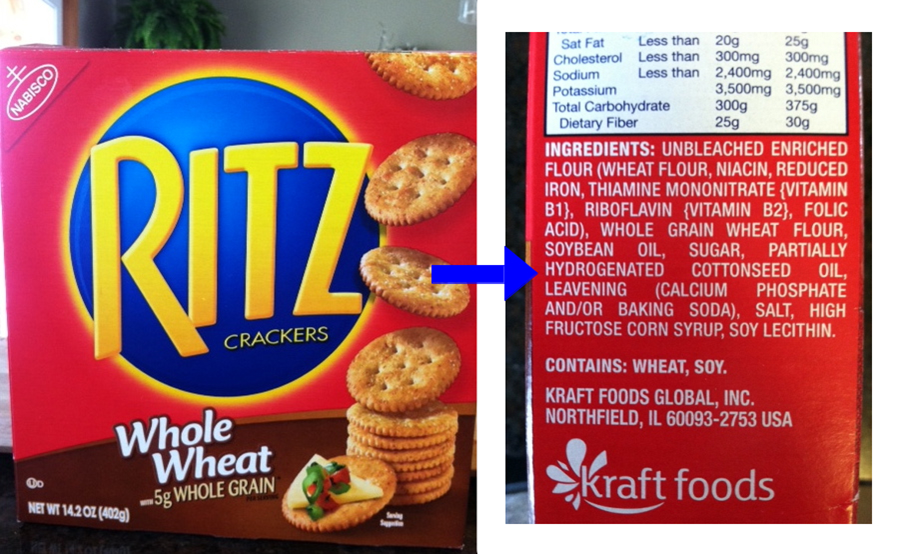
Now, have a look at the nutrition facts label comparison of Ritz crackers vs mini carrots. Look at the highlighted areas. So to have 80 calories worth of carrots, you would eat about 16 carrot sticks. That would fill me much more than 3 ritz crackers and give me more natural nutrients including vitamin A, which is great for our skin!!
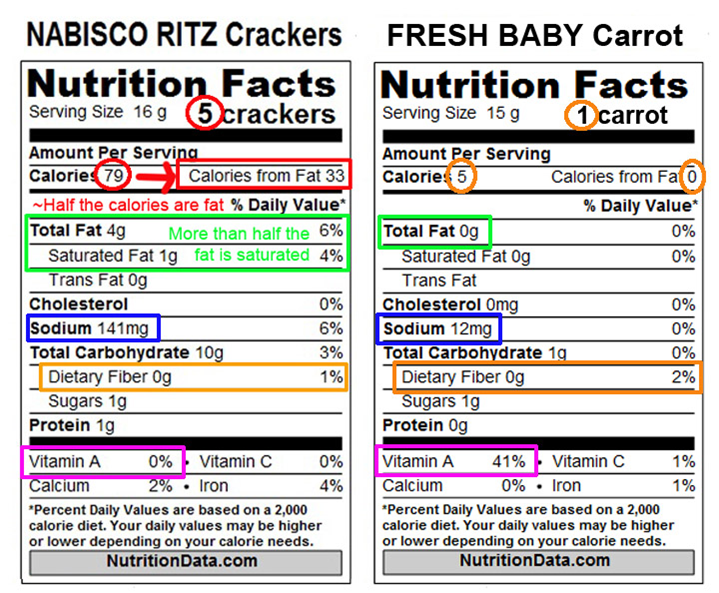
If I am buying something with a label, I will look at the sugar content. One teaspoon of granulated sugar equals 4 grams of sugar on a nutrition facts label. To put it another way, 16 grams of sugar in a product is equal to about 4 teaspoons of granulated sugar. See the below can of coke has 39 grams of sugar, which is almost 10 teaspoons of sugar that you are simply drinking. It doesn’t give you any nutritional value, you aren’t feeling full from it and your blood sugar spikes. This is how inflammation happens in your body as well as your skin, like acne, eczema and aging. So watch out for that. Especially with ‘healthy’ options, they put extra sugar in to make it taste good, so you want to have more!! For example, kombucha is becoming popular because it’s good for our digestive health, but watch the sugar content in that too.
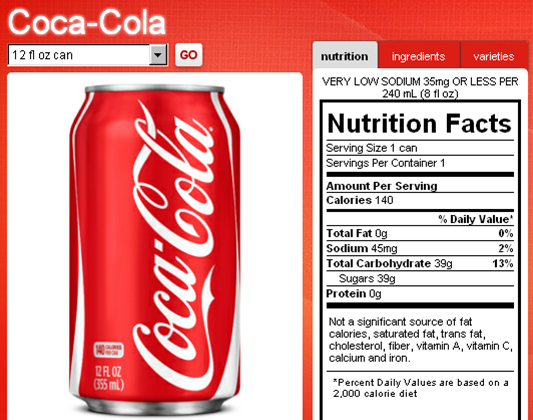
The Most Important Part of a Nutrition Label
My most important advice about reading nutrition labels is to ignore the ‘Nutrition Facts’ panel. All you need to know about food is in the ingredient list. Turn the package over and find the ingredient list on the side or on the back. Are there real foods on there, or is there a mixture of ingredients you don’t know and can’t pronounce? What you see in the ingredient list is the most important thing to use to make your buying decision.
And, even better yet, don’t buy things with labels at all! Imagine a perfect world where you can eat what you want. You don’t have to put on your reading glasses to go grocery shopping. You don’t need a kitchen scale and calculator to figure out what to eat. You don’t need to log calories or have a degree in food science to cook a balanced meal. Imagine a world where you sit down to a meal and actually enjoy the food for its flavours and natural health benefits. This is a world where our food doesn’t have a shelf life that extends into the next 5 years.
This world, actually, does exist! It’s shopping at your local farmer’s market or grocery store where you find clean fruits, vegetables, eggs, and meats. This is the magical land of the whole, natural, unprocessed foods. Apples don’t have a health label when you buy them. There’s no ingredient list or health claims, as it doesn’t have a package to write them on.
The more we focus on foods that don’t have labels, the less we’ll care about reading nutrition labels and the numbers listed there.
Taking a few extra minutes to prep some simple whole-food healthy snacks for yourself and your family will help to improve everyone’s health for the better. Check out my Simple Snacks blog here https://www.rainnaturalskincare.com/simple-summer-snacks/ for a few ideas.
Here’s to your health,
